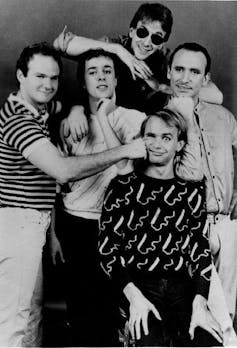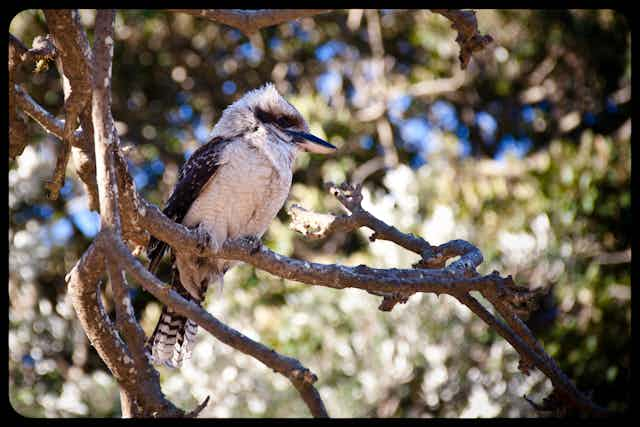Australian copyright law is broken, and the Australian Government isn’t moving quickly to fix it.
Borrowing, quoting, and homage are fundamental to the creative process. This is how people are inspired to create. Under Australian law, though, most borrowing is copyright infringement, unless it is licensed or falls within particular, narrow categories.
This year marks five years since the very real consequences of Australia’s restrictive copyright law for Australian artists were made clear in the controversial litigation over Men at Work’s 1981 hit Down Under. The band lost a court case in 2010 that found that the song’s iconic flute riff copied some of the 1934 children’s song Kookaburra Sits in the Old Gumtree.
A new book and documentary tell us more about the story behind the anthem – and the court case. The book, Down Under by Trevor Conomy, and the documentary, You Better Take Cover by Harry Hayes, bring renewed interest and new perspectives on the tragic story.
Why so note-worthy?
Kookaburra is a simple, four-bar tune. Men at Work were found liable for copying two of these bars. The Court found that this copying was sufficient to award Larrikin Music Publishing – the current owners of Kookaburra Sits in the Old Gumtree - 5% of Down Under’s royalties from 2002 onwards.
According to Conomy and Hayes, this decision has been heavily criticised by Australian artists. Copyright is designed to promote creativity, but this is a clear case where it punishes artists for drawing from the culture around them. In Hayes’ documentary, cartoonist Michael Leunig says:
A quotation or a tribute or a homage if you like, where you quote from the culture you grew up on, is entirely natural and spontaneous and proper. It reinforces and celebrates culture. It’s culture making. And I grew up on that song. I mean at school we sang that song day and night. It just goes into you – it belonged to us all.
Crucially, Conomy and Hayes both point out that the people who sued Men at Work didn’t even write Kookaburra Sits in the Old Gumtree. Poet and composer Marion Sinclair penned the song for a Girl Guides competition in 1934, and later assigned her copyright in the work to Larrikin.
The association between the two songs wasn’t brought to Larrikin’s attention until almost 30 years after the release of the 1979 and 1981 recordings of Down Under, following an episode of the ABC television program Spicks and Specks.
Hayes’ documentary points out that Sinclair would likely have heard the song Down Under at some point during the last years of her life. Presumably, she either didn’t recognise the Kookaburra Sits in the Old Gumtree tune or didn’t care. Many of the subjects in the documentary describe how she had a generosity of spirit with respect to sharing her song and connecting communities in a way that Larrikin evidently didn’t.
The ongoing problem with copyright
Recent controversies like the Blurred Lines case show that there is an ongoing problem with copyright. It seems clear from these cases that copyright is not serving its original purpose.

Ideally, we don’t want our artists to feel the need to “take cover” – they should be encouraged to make and produce new works, as copyright was originally intended.
What makes the story of Men at Work’s greatest single so striking – and worthy fodder for a book and documentary – is the inadvertent way that the copyright infringement was discovered and the tragic aftermath of the court decision.
On 19 April 2012, Men at Work’s flautist Greg Ham was found dead in his home. In Hayes’ documentary, Men at Work’s drummer Jerry Speiser describes the case as being “just another nail in Greg’s coffin.” He said, “I wouldn’t say it was the cause of his death but it certainly contributed”.
While copyright law is not fully responsible for Ham’s tragic death, it is not difficult to see how such a finding of copying would devastate any artist and undermine their integrity as a creative professional.
A fairer copyright law
In an exhaustive report released in February 2014, the Australian Law Reform Commission recommended that Australia should introduce more flexibility into our copyright law.
The key recommendation was to create a new “fair use” exception that would allow artists more creative freedom in borrowing and quoting from existing works.
Currently, copying without permission is only permitted if it falls under a prescribed purpose – such as for research or study, criticism or review, parody or satire, and reporting the news. There is no exception that allows artists to quote and rework the material that inspires them.
Fair use allows courts to excuse copying that isn’t harmful. Greg Ham’s flute riff is exactly the kind of tribute that imposes no costs on the original creator. Both the documentary and the book point out that, in fact, this is not just harmless copying of copyright expression – it’s exactly the kind of creativity that Australian copyright law should encourage.
So far, the Australian Government has not taken up the ALRC’s recommendations. Reform in this area is much needed and urgent – if we had had a fair use exception before 2010, the outcome of the Down Under case could have been very different. Certainly, it would have been much fairer.
Down Under by Trevor Conomy is published by Affirm Press on August 1. Watch the trailer for the documentary You Better Take Cover by Harry Hayes here.

